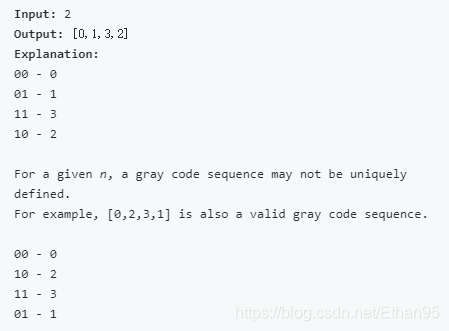地址:https://leetcode.com/problems/gray-code/
题目:
The gray code is a binary numeral system where two successive values differ in only one bit.
Given a non-negative integer representing the total number of bits in the code, print the sequence of gray code. A gray code sequence must begin with 0.
Example 1:

Example 2:

理解:
有点像permutation,想到用backtracking求解,但是具体实现还是有些不太一样吧,下面是我的实现,但是并不能跑出来正确的结果。
实现:
class Solution {
public:
vector<int> grayCode(int n) {
vector<string> res;
string tmp(n, '0');
dfs(res, tmp, 0, n);
vector<int> intRes(pow(2,n),0);
for (int i = 0; i < res.size(); ++i)
intRes[i] = trans(res[i]);
return intRes;
}
private:
void dfs(vector<string>& res, string& tmp, int beg, int n) {
if (beg == n) {
res.push_back(tmp);
return;
}
for (int i = beg; i < n; ++i) {
dfs(res, tmp, i + 1, n);
tmp[i] = '1';
}
}
int trans(const string& str) {
int res = 0;
for (int i = 0; i < str.length(); ++i) {
res *= 2;
res += str[i] == 0 ? 0 : 1;
}
return res;
}
};
这样应该是不行的,改成1以后就改不回来了,不能满足gray码的特点。是不是可以多用一个数组去记录是第几次访问?但是好像也不太好实现。参考下别人的方法,其中flip这个操作,会先把0变成1,当第二次再调用的时候会把1再变回0。
class Solution {
public:
vector<int> grayCode(int n) {
bitset<32> bits;
vector<int> res;
backtracking(bits, res, n);
return res;
}
private:
void backtracking(bitset<32>& bits, vector<int>& res, int k) {
if (k == 0) {
res.push_back(bits.to_ulong());
return;
}
backtracking(bits, res, k - 1);
bits.flip(k - 1);
backtracking(bits, res, k - 1);
}
};
实现2:
还可以用非递归的方法,利用gray码的特点,长为n的格雷码,就是长为n-1的前面加0和长为n-1的逆序排列,在前面加1。
class Solution {
public:
vector<int> grayCode(int n) {
vector<int> res(1, 0);
for (int i = 0; i < n; ++i) {
int preCnt = res.size();
int tmp = (1 << i);
while (preCnt) {
res.push_back(tmp + res[preCnt - 1]);
--preCnt;
}
}
return res;
}
};